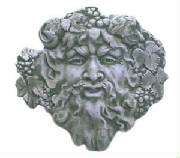|

|
| The face of a Greenman |
The Celts were a people that lived in Europe a few thousand years ago. These were the people from which druids became
famous. Stone Henge was constructed during the reign of the Celts. Unfortunately, the common thoughts of these peoples are
that they were barbarous, uncivilized, and unclean. To some, the Celts were a people that are interesting, but do not have
any effect on todays society. They were, in fact, just an ancient civilization that we still do not completely understand.
And to say that they did not effect the present would be very untrue. For example: Halloween. The fabled Saints Day was
in fact originally a Celtic Holiday celebrated on the first of November, signifying the new year and the beginning of winter.
This holiday was called Samhain. On this day, people would frequently give offerings to or for the dead, to help them on
their way to the afterlife, as well as to keep them from the living. After the Christians began their take over of different
religions, they incorporated Samhain as All Hallows Eve, a Christian version of the original holiday, but with a focus on
spirits and demons, mostly for people to fear them. Our costumes come from people dressing up as replicas of the deceased
and trick or treating is a mimic of mumming, an ancient ritual when people would put offerings to the dead outside their door,
and those dressed as the spirits would take them (Santino 43-50). With such a prominent part of our culture stemming from
an ancient practice of the Celts, calling this ancient people irrelevant would be a gross understatement.
2. The smaller the population size, the greater the frequency in alleles. The percentage is a constant around 50%.
3. As with the being at 100%, the smaller the population size, the greater the frequency in the alleles. However, instead
of the drops from generation to generation. This occurs more gradually in the larger population sizes, but more quickly in
the smaller populations.
4. As with the two previous simulations, allele variation is greater in smaller population sizes and less frequent in
larger population sizes. Contrary to either of the previous simulations, however, the percentage rises as opposed to staying
constant in the first simulation and dropping in the second. In all population sizes, the rate at which the percentages rise
are all similar to each other, as opposed to three, where population size did effect the percentages.
5. The allele frequency never reaches above 50%. New alleles are not very frequent, nor do the give as much variation
in a population.
6. There is a much larger frequency than number 5. This leads on to believe that the less the genotype frequency, the
larger the variation in alleles.
|

